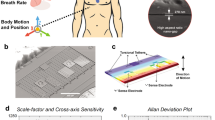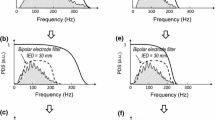Abstract
The piezoelectric contact sensor has been widely utilised in mechanomyography (MMG). The authors aim to clarify the mechanical variables (i.e. acceleration, velocity or displacement) reflected by the MMG signal detected with a piezoelectric contact sensor (PEC), and compare the results with those obtained simultaneously by an accelerometer (ACC). To measure the acceleration-frequency response, a mechanical sinusoidal excitation of 5 to 300 Hz at a constant magnitude of 0.01 G was applied to the two transducers. The acceleration-frequency response of the ACC transducer was confirmed to be almost flat. The PEC without any restriction of the transducer housing (including the combined seismic mass) demonstrated a similar response to the ACC transducer. The PEC transducer output with restricted housing decreased with increasing sinusoidal frequency and an attenuation slope of −40 dB/decade and phase angle of −180 degrees. The voluntary MMG signal during isometric knee extension was recorded simultaneously with the two transducers. The amplitude spectral density distribution of the MMG from the PEC transducer was narrow and the mean frequency was approximately one-half that obtained from the ACC tranducer. The amplitude spectral density distribution with the PEC transducer resembled that of the double integral over time of the ACC transducer signal. The phase angle of the PEC transducer signal was different from that of the ACC transducer signal by approximately −180°. These results suggest that the PEC transducer acts as a displacement meter of muscle vibration. In addition, differences in the MMG frequency components relating to the transducer type must be taken into consideration when investigating the mechanical activity of muscle.
Similar content being viewed by others
References
Barry, D. T., Geiringer, S. R., andBall, R. D. (1985): ‘Acoustic myography: a noninvasive monitor of motor unit fatigue’,Muscle Nerve,8, pp. 189–194
Barry, D. T., andCole, N. M. (1988): ‘Fluid mechanics of muscle vibrations’,Biophys. J.,53, pp. 899–905
Barry, D. T. (1991): ‘Muscle sounds from evoked twitches in the hand’,Arch. Phys. Med. Rehabil.,72, pp. 573–575
Barry, D. T. (1992): ‘Vibrations and sounds from evoked muscle twitches’,Electromyogr. Clin. Neurophysiol.,32, pp. 35–40
Barry D. T. (1997): ‘Acoustic myography’,Muscle Nerve,20, pp. 251–252
Bolton, C. F., Parker, A., Thompson, T. R., Clark, M. R. andSterne, C. J. (1989): ‘Recording sound from human skeletal muscle: technical and physiological aspects’,Muscle Nerve,12, pp. 126–134
Chu, A. S., Eller, E. E., andWhittier, R. M. (1996): ‘Vibration transducers’,in Harris, C. M. (Ed.): Shock and vibration handbook, fourth edition’ (McGraw-Hill, 4th edn.), pp. 12.1–12.39
Cole, N. M., andBarry, D. T. (1994): ‘Muscle sound frequencies of the frog are modulated by skeletal muscle tension’,Biophys. J.,66, pp. 1104–1114
Diemont, B., Figini, M. M., Orizio, C., Perini, R., andVeicsteinas, A. (1988): ‘Spectral analysis of muscular sound at low and high contraction level’,Int. J. Biomed. Comput.,23, pp. 161–175
Esposito, F., Malgrati, D., Veicsteinas, A., andOrizio, C. (1996): ‘Time and frequency domain analysis of electromyogram and sound myogram in the elderly’,Eur. J. Appl. Physiol.,73, pp. 503–510
Gordon, G., andHolbourn, A. H. S. (1948): ‘The sounds from single motor units in a contracting muscle’,J. Physiol.,107, pp. 456–464
Harris, C. M. (1996): ‘Measurement techniques’,in Harris, C. M. (Ed.): ‘Shock and vibration handbook’ (McGraw-Hill, 4th edn.), pp. 15.1–15.22
Herroun, E. F., andYeo, G. F. (1885): ‘Note on the sound accompanying the single contraction of skeletal muscle’,J. Physiol.,6, pp. 287–292
Hixson, E. L. (1976): ‘Mechanical impedance’,in Harris, C. M., and Crede, C. E. (Eds.): ‘Shock and vibration handbook’ (McGraw-Hill 2nd edn.)
Keidel, M., andKeidel, W-D. (1989): ‘The computer-vibromyography as a biometric progress in studying muscle function’,Biomed. Tech.,34, pp. 107–116
Lammert, O., Jørgensen, F., andEiner-Jensen, N. (1976): ‘Accelerometermyography (AMG) I: method for measuring mechanical vibrations from isometrically contracted muscles’,in Komi, P. V. (Ed.): ‘Biomechanics V-A’ (University Park Press, Baltimore) pp. 159–164
Maton, B., Petitjean, M., andCnockaert, J. C. (1990): ‘Phonomyogram and electromyogram relationships with isometric force reinvestigated in man’,Eur. J. Appl. Physiol.,60, pp. 194–201
Orizio, C., Perini, R., Diemont, B., Figini, M. M., andVeicsteinas, A. (1990): ‘Spectral analysis of muscular sound during isometric contraction of biceps brachii’,J. Appl. Physiol.,68, pp. 508–512
Orizio, C. (1992): ‘Soundmyogram and EMG cross-spectrum during exhausting isometric contractions in humans’,J. Electromyogr. Kinesiol.,2, pp. 141–149
Orizio, C., andVeicsteinas, A. (1992): ‘Soundmyogram analysis during sustained maximal voluntary contraction in sprinters and long distance runners’,Int. J. Sports Med.,13, pp. 594–599
Orizio, C. (1993): ‘Muscle sound: bases for the introduction of a mechanomyographic signal in muscle studies’,Crit. Rev. Biomed. Eng.,21, pp. 201–243
Orizio, C., Esposito, F., andVeicsteinas, A. (1994): ‘Effect of acclimatization to high altitude (5,050 m) on motor unit activation pattern and muscle performance’,J. Appl. Physiol.,77, pp. 2840–2844
Orizio, C., Liberati, D., Locatelli, C., De Grandis, D., andVeicsteinas, A. (1996): ‘Surface mechanomyogram reflects muscle fibres twitches summation’,J. Biomech.,29, pp. 475–481
Reed, F. E. (1996): ‘Dynamic vibration absorbers and auxiliary mass dampers’,in Harris, C. M. (Ed.): ‘Shock and vibration handbook’, (McGraw-Hill, 4th edn.), pp. 6.1–6.42
Stokes, M. J., andDalton, P. A. (1991): ‘Acoustic myography for investigating human skeletal muscle fatigue’,J. Appl. Physiol.,71, pp. 1422–1426
Vermarien, H., andVan Vollenhoven, E. (1984): ‘The recording of heart vibrations: a problem of vibration measurement on soft tissue’,Med. Biol. Eng. Comput.,22, pp. 168–178
Wee, A. S., andAshley, R. A. (1989): ‘Vibrations and sounds produced during sustained voluntary muscle contraction’,Electromyogr. Clin. Neurophysiol.,29, pp. 333–337
Wee, A. S., andAshley, R. A. (1990): ‘Transmission of acoustic or vibratory signals from a contracting muscle to relatively distant tissues’,Electromyogr. Clin. Neurophysiol.,30, pp. 303–306
Wollaston, W. H. (1810): ‘On the duration of muscle action’,Philos. Trans. R. Soc. Lond. B. Biol. Sci., pp. 1–5
Zhang, Y.-T., Frank, C. B., Rangayyan, R. M., andBell, G. D. (1992): ‘A comparative study of simultaneous vibromyography and electromyography with active human quadriceps’,IEEE Trans. Biomed. Eng.,39, pp. 1045–1052
Zwarts, M. J., andKeidel, M. (1991): ‘Relationship between electrical and vibratory output of muscle during voluntary contraction and fatigue’,Muscle Nerve,14, pp. 756–761
Author information
Authors and Affiliations
Corresponding author
Rights and permissions
About this article
Cite this article
Watakabe, M., Itoh, Y., Mita, K. et al. Technical aspects of mechnomyography recording with piezoelectric contact sensor. Med. Biol. Eng. Comput. 36, 557–561 (1998). https://doi.org/10.1007/BF02524423
Received:
Accepted:
Issue Date:
DOI: https://doi.org/10.1007/BF02524423




